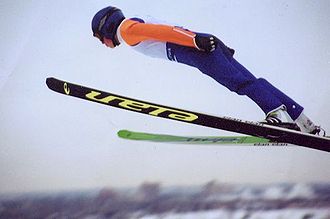Ski jumping
Ski jumping is, mostly, a winter sport performed on snow where skiers go down a take-off ramp, jump forward and land as far as possible down the hill below. Judges give points both for length of the jump and for the jump style. The skis used for ski jumping are wide and long (260 to 275 centimetres (102 to 108 in)). Ski jumping is a part of the Winter Olympic Games. True ski jumping originates in Norway in 1809 when a Norwegian lieutenant launched himself 9.5 metres in the air in front of his soldiers. The first widely known ski jumping competition was held in Oslo in 1879, with Olaf Haugann of Norway setting the first world record for the longest ski jump at 20 metres(meters)[1]
 Peter Prevc in Titisee-Neustadt, March 2016 | |
| Highest governing body | International Ski Federation (FIS) |
|---|---|
| First played | 22 November 1808 Olaf Rye, Eidsberg church, Eidsberg, Norway |
| Characteristics | |
| Team members | M Individual (50) L Individual (40) Team event (4) Super Team event (2) |
| Type | Nordic skiing |
| Equipment | Skis |
| Venue | Ski jumping hill |
| Presence | |
| Olympic | 1924 (men) 2014 (women) 2022 (mixed team) |
| World Championships | 1925 (men's nordic) 1972 (ski flying) 2009 (women's nordic) |

Ski jump techniques are divided into four sections; 1) In-run, 2) Take-off (jump), 3) Flight and 4) Landing. In each part the athlete is required to pay attention to and practice a particular technique in order to maximize his or her length and style marks.[2]
Ski Jumping Media
Herman Paus jumping in Hyttlibakken at Tryvannshøgda ca. 1919
The Salpausselkä ski jumping hill in Lahti, Finland
Sara Takanashi is the most successful female ski jumper, winning the World Cup title on four occasions.
Sepp Bradl became the first ski jumper to surpass 100 meters in 1936.
In 2003, Daniela Iraschko became the first ever female ski jumper in history to reach 200 meters.
Related pages
Notes
| Wikimedia Commons has media related to Lua error in Module:Commons_link at line 62: attempt to index field 'wikibase' (a nil value).. |










